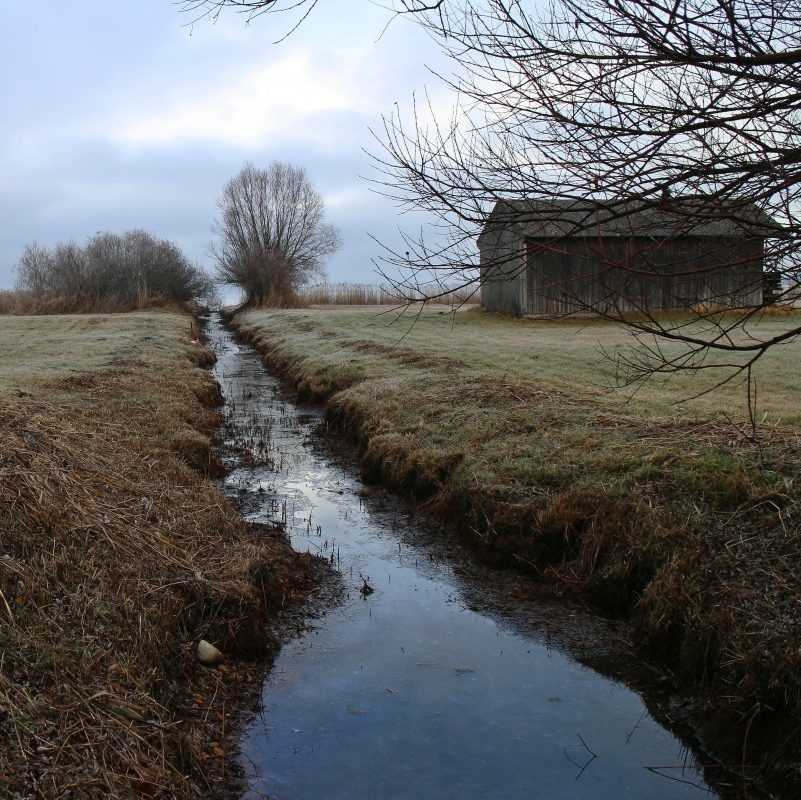ALGAL BLOOMS
Most algae are harmless and are an important part of the food web. Certain types of algae can grow quickly and form blooms, which can cover all or portions of a lake. Even large blooms are not necessarily harmful. However some species of algae-like organisms called cyanobacteria can produce toxins that can be harmful to people and animals. Blooms of cyanobacteria can produce toxins and are referred to as harmful algal blooms (HABs).
HABs typically occur during the summer, but can also occur throughout the entire year. They are likely triggered by a combination of water and environmental conditions that may include: excess nutrients (phosphorus and nitrogen), sunlight and warm temperatures, low-water or low-flow conditions, and calm water. HABs may be short-lived (appearing and disappearing in hours) or long-lived (persisting for several weeks or more).
It can be difficult to visually distinguish true algae and free-floating aquatic plants (e.g., duckweed and watermeal) from cyanobacteria without further evaluation of other water quality parameters and/or microscopy. Visual indicators and characteristics of HABs are bright and unusual colors like solid green to blue-green, red, purple, brown, or milky white. The water may look crusty, filmy, foamy, thick, or like pea soup or spilled paint. Blooms may appear as clumps or streaks, or as scums or floating mats that can wash up on shorelines. Blooms may float on the surface and/or be dispersed throughout the water column. Cyanobacteria can actually move up and down in the water column – appearing shallower or deeper in just a matter of hours.
If someone suspects a HAB, they should avoid contact! Keeps pets and livestock away. The use of untreated surface water for eating, drinking, ice or other food related purposes should always be avoided. Using surface water during an algal bloom, even if it is treated is not recommended, because in-home treatments such as boiling, disinfecting water with chlorine or ultraviolet (UV), and water filtration units do not protect people from HABs toxins.
A suspected HAB should be reported to DEC so that it can be evaluated and posted on their website for public education. The Suspicious Algal Bloom Report Form should be completed, and if possible photos attached, both close-up for visual identification purposes and landscape view to show extent and location. If someone is unable to complete the form, DEC does have an email address that is monitored regularly HABsInfo@dec.ny.gov.
After swimming/wading in water, even with no visible HABs, individuals should rinse off with fresh water as soon as possible. If symptoms occur after exposure to untreated water, such as rashes, blisters and hives, and eye and nose irritations, or if swallowed, diarrhea, vomiting, abdominal pain, numbness of lips, tingling in fingers and toes, dizziness, or headache occur – seek immediate medical attention!
When DEC receives a report, they conduct a professional evaluation of all the information provided, and make a decision about the presence of a HAB. Due to the nature of HABs, that decision is usually conservative and a suspected bloom is often confirmed. Confirmed blooms are posted on the HABS location map (NYHABS) which can be accessed by going to: http://www.dec.ny.gov/chemical/83310.html. Every afternoon DEC compiles a list of new confirmed HABs and forwards that information to the Governor’s office and the Department of Homeland Security and Emergency Services.
DEC also communicates and collaborates daily with State Department of Health (DOH) about HAB reports. There are other protocols for beaches and water supplies with regard to both reporting to DOH and beach closures, notifications, water use, etc. In some instances, like when the lake is part of another water quality monitoring program, a water sample may be taken. It does take 7-10 days for toxin results, and that information is used internally to help with the evaluation. State DOH communicates and coordinates with local DOH offices.
DEC does not have the authority to close a lake in the event of a bloom, although they can close beaches that are operated by DEC (limited to a small number of beaches within the Adirondack and Catskill Parks). The NYS Office of Parks and Recreation, County officials and/or local Department of Health have the authority to close swimming beaches. Beach operators close beaches as needed to assure public health and safety.
The basic message is KNOW IT, AVOID IT, REPORT IT! Before you go in the water, find out what waterbodies have blooms or have had them in the past. DEC ‘s HABs Notifications page http://www.dec.ny.gov/chemical/83310.html links to the map of waterbodies that currently have blooms. However if a waterbody is not listed, it does not mean that it does not have a bloom. It may have one that was not reported, so diligence to KNOW means understanding what a bloom looks like and taking personal responsibility to AVOID IT, and REPORT IT for others too!
The DEC website contains useful information about HABs – KNOW IT, AVOID IT, REPORT IT! https://www.dec.ny.gov/chemical/77118.html













